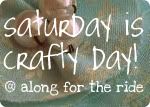She (he?) is my second entry (see the first here if you missed it) in the cardboard box round of the Iron Crafter over at Fireflies and Jellybeans. I decided to use cardboard along the lines of one of its first uses: as a replacement for wood. (Instead of building wooden crates to ship goods, US merchants started using cardboard boxes way back in 1895.) I love carved wood signs, but I lack the wood cutting tools and prowess. Until Debra and I have the means and geographic proximity to make our dreams of a shared crafting barn -- filled with tools and supplies and probably a limeade bar (my contribution) -- a reality, I will have to content myself with cutting cardboard instead.
My elephant-loving (yet otherwise completely normal) sister in Oregon just moved into a beautiful new (to them) house with plenty of room for her 4 children and 3 dogs, so I wanted to make her a nice housewarming gift. Hope you like it, Greta! If you are an elephant lover yourself or have one (otherwise normal or not) in your family, you can make your own elephant welcome sign.
Time spent:approximately 3 hours, plus paint/glue drying time
Money spent:$0! Everything on hand. Love that. :)
Finished dimensions: approximately 11W (including tail) x 12H (not including hanging ribbon)
What you'll need
- Elephant and welcome templates (download below or here)
- Giving credit where credit is due: I did not draw the elephant myself. I used this African Elephant silhouette from fun-with-pictures.com to create the separate shapes for the head, body, and tusks.The file I have available for download is the separate shapes.
- Large-ish cardboard box, opened flat (mine was 24Lx9Dx13H, not including the top/bottom flaps)
- Box cutter
- X-acto knife
- Scissors
- ModPodge or other sturdy glue and glue stick
- Craft paint: light gray, dark gray, ivory, and the color you want Welcome (I used Apple Barrel's Country Grey, Pewter Grey, Satin Cream, and Sage Green)
- Paint brush (or two)
- Ribbon
- Several big, heavy books (I used phone books)
- A small strip (1/2 inch long) of clear plastic, like used in packaging (mine was from my son's first toothbrush! you know your mom is a crafter when...)
What you'll do
First, read these notes:
Tips for cutting cardboard
Don’t think of cutting cardboard as cutting like you’d carve a piece of wood. Cardboard doesn’t cut that smoothly. The technique that works for me is more of a stabbing motion where the small cuts connect to make a (more or less) continuous cut. Henceforth this shall be called the stab-cut.
- Start by stab-cutting a 1-2 inch section following your outline. Make sure that your box cutter blade is locked into position (safety!) and the blade is just longer than your cardboard is wide.
- Then move 1-2 inches one side or the other from that and stab-cut toward the section that you just cut.
- Rinse and repeat until you've stab-cut your whole outline.
- Once you’ve completed the outline of your shape, start gently punching it out. Watch the back and carefully re-cut any of the outer cardboard paper that wasn’t fully severed by your previous stab-cuts.
For finer details like the letters and the elephant’s tail, use a good sharp X-acto knife. Start with the inner parts of the letters (the hole in the O, for example). When you’ve cut the entire shape out, trim and even out the edges carefully with your paper-cutting scissors.
Be sure to have a firm surface underneath the cardboard you are cutting to help make clean, even cuts. This is especially important when cutting finer details. Another sheet of cardboard makes a firm enough surface to cut on without the worry of cutting into other firm surfaces, like kitchen tabletops. Not that there are any box-cutter scars on my tabletop. At least as far as my husband knows (shh!).
About dry-brushing
Dry-brushing is basically painting with a very dry brush (one with very little paint on it) to give a rough, scratchy look.
- Dip your brush (very stiff bristle or foam) in a tiny bit of paint.
- On a scrap piece of cardboard, dab until almost all of the paint is off the brush, so that you can see the texture of the brush when you dab. Too much paint will go on smoothly, and you want a rough texture, so err on the side of less, not more, paint.
- Gently dab and brush with round strokes to spread a very thin layer of the paint to give your elephant (or whatever else you're painting) a mottled, rough look.
Preparing the elephant
- Print the templates and cut out the elephant's head, body, and tusks.
- The elephant's body is just barely too large for a single piece of paper, so when you print that page, look for Page Scaling and select Tile large pages. My printer has an extra large bottom margin, so I scaled the image to 95% so that the elephant's body would print on two sheets instead of four.
- Trace two heads, two bodies, and one set of tusks on the non-printed side of your cardboard box.
- Using your box cutter and/or X-acto knife, start cutting out the traced pieces. If you've never cut cardboard before, you might want to check out my tips above if you didn't already.
- Keep cutting until you have two… three… four… five, six pieces: two heads (identical), two bodies (identical) and two tusks (one left and one right).
- Line up your identical head and body pieces and trim any rough or uneven edges so that they match perfectly. Almost perfectly is also acceptable. :)
- Spread a generous coat of ModPodge on one of the head pieces.
- Lay the other head piece on top of the glue and press them tightly together, making sure they are lined up properly. The cardboard will start to curl and warp with the moisture, so...
- Flatten on a hard surface underneath several large, heavy books (like phone books... or family history) until dry.
- Repeat the gluing and flattening for the elephant body pieces.
- Once the glue is dry, paint the double-thick head and body pieces with two coats of the lighter shade of gray paint and the tusks with two coats of ivory paint, allowing the paint to dry between coats
- Bonus Iron Crafter points for also using cardboard scrap for your paint palette ;)
- Also, I paint inside... on carpet... using one of the diaper changing pads that they give with the free diaper bags at my doctor's office. I was using it for a painting mat long before I had a baby! Works like a dream, then fold it up and stow it away.
- Dry-brush the head and body pieces with the darker shade of gray. See my note above about dry-brushing. Just in case you skipped it. ;)
Preparing the Welcome (or other words)
If you'd like to have an elephant with other words, you can download (free) the same font I used. The font is Lauren Script and it's available from DaFont here. If you'd like just the elephant, skip this section.
- Cut the printed Welcomes apart, leaving plenty of paper around the edges.
- Lightly glue (glue stick) both printed Welcomes to your cardboard
- In the file I provided, one Welcome is reversed. The letters require more cutting precision, and sometimes that's more achievable cutting from the back of the letters. So I gave you options. :) If you use it, you'll glue the reversed Welcome (the emocleW ;) ) on the printed side of your cardboard instead. Either way, be sure you have two Welcomes.
- Using the X-acto knife, cut out both Welcomes.
Be sure to read my tips above! Cardboard isn't really built for precision cutting, but some practice has helped me learn. :) - Glue the two Welcomes together with a good amount of ModPodge, inserting the small piece of plastic piece in between to two in order to to hold the W to the elcome.
- I originally included the plastic piece because I was going to hang the Welcome beneath the elephant. If you decide to glue it on top, like I did, the plastic is unnecessary but still nice to hold the word together.
- Flatten the double-thick Welcome beneath your thick books until dry.
- Paint the Welcome with two coats, allowing the paint to dry between coats.
Assembling the sign
As you assemble the sign, you might want to look back at the original African elephant silhouette on fun-with-pictures.com for help with the positioning of the tusks and the head.
- Glue tusks on elephant head, using a small amount of ModPodge, and let dry.
- With a more generous helping of ModPodge, glue elephant's head on his (her?) body. I chose to glue only the top portion of the head and let the warped curve of the trunk add some character and depth to the elephant.
- Flatten the head-body combo under your heavy books until dry.
- Glue the Welcome across the elephant's feet and let dry. (If the cardboard starts to warp again, press with books to flatten like before. Mine didn't on this step, though.)
OR glue 3-inch lengths of 1/4-inch ribbon to the back of the W, l, and e to hang the Welcome beneath elephant, as was my original vision. - Determine and mark your elephant's center of gravity so that she (he?) will hang straight once you've attached the ribbon. (I held the elephant at different points between two fingers to see where it would hang straight.)
- Spread a generous coat of ModPodge all around your center-of-gravity mark.
- Lay one end of a 24-ish-inch ribbon piece flat in the ModPodge on one side of the mark and the other end flat on the other side of the mark.
AND glue your Welcome ribbons to the back of the elephant if you've chosen to have a hanging welcome. - On top of your ribbon ends, spread another generous coat of ModPodge.
- Dry the ModPodge well.
- Display! Or, in my case, ship.
Also, since I'm sending my elephant off to rainy Oregon, I will be spraying him (her?) with a coat or two of a clear finish to help protect from the extra moisture in the air. We have very little moisture in this desert state of mine. :)
You may have noticed that I'm having trouble determining the gender of this elephant... It is a him? a her? any insight as to the gender of a cardboard creation? I think he or she needs a name, but I guess I'll leave that up to the recipient...

 I'm entering Round 5: Cardboard Boxes of the Iron Crafter at Fireflies and Jellybeans with my fantastic elephant friend. There's some pretty stiff competition over there! My favorites so far are the playhouse, stick horse, and treasure chest from a diaper box. I value my diapers above gold but I've never thought "treasure chest" when looking at a diaper box... Genius.
I'm entering Round 5: Cardboard Boxes of the Iron Crafter at Fireflies and Jellybeans with my fantastic elephant friend. There's some pretty stiff competition over there! My favorites so far are the playhouse, stick horse, and treasure chest from a diaper box. I value my diapers above gold but I've never thought "treasure chest" when looking at a diaper box... Genius.He (She?) is also a proud product of Stashbusting September.
And I'm linking up at these lovely parties:
























0 comments:
Post a comment on: An Elephant's Welcome {cardboard sign}